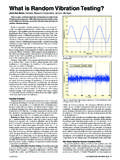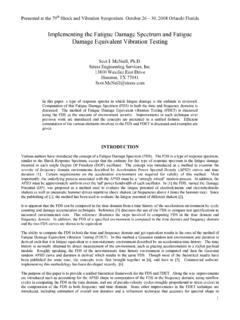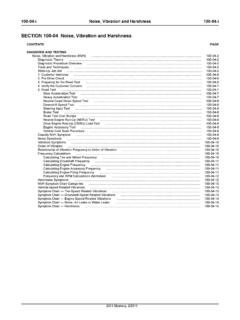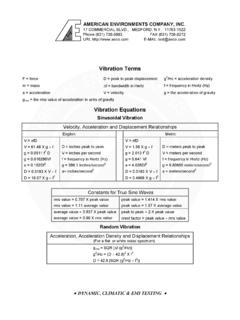Transcription of Structural Developments Improve High-Frequency Vibration ...
1 11591 Watertank Rd. Burlington, WA 98233 Telephone: Fax: 1 Joel Hoksbergen, Team Corporation, 11591 Watertank Rd., Burlington, WA, 98232, Structural Developments Improve High-Frequency Vibration Testing on a CUBE Multi-Axis System 84th Shock and Vibration Symposium, Atlanta, GA, November 3- 7, 2013 Author: Joel Hoksbergen1, Bill Woyski Revision: A Abstract: The frequency response of a multiple-input, multiple-output (MIMO) Vibration test system is typically limited by the dynamic response of the table structure between the Vibration exciters and the test payload. The primary design goal in developing this structure is to minimize the moving mass and maximize the stiffness to give the highest possible first Vibration mode, while realizing all other Structural requirements. Many Department of Defense random Vibration test profiles have a 500 Hz bandwidth, and depending on the system and test article, often the first mode of the loaded table structure must be outside of the test bandwidth to adequately control the test.
2 This is a challenging requirement when the Vibration system is multi-axis and the test spectra are excited simultaneously on all axes. Team Corporation addressed these issues with a special version of the Cube six degree-of -freedom (6-DOF) Vibration test system. The challenges of the design requirements and the development of a structure with a frequency response that exceeds 500 Hz are discussed. Additionally, test results from the MIL-STD-810G Common Carrier random Vibration profiles are presented for the final design and for two of these Cubes operated simultaneously with a bridging test article. SAVE 2013 Vibration III Session Page | 1 of 16 Contents 1 Introduction .. 2 2 Design Requirements .. 3 3 Original Design .. 5 Response of Original Design .. 5 Operating Deflection Shapes .. 6 4 Redesigned Structure .. 8 Design Approach .. 8 Design Fundamentals.
3 8 Detailed Design .. 9 5 Single Cube Test Results .. 11 6 Dual Cube Test Results .. 13 7 Conclusions .. 16 8 References .. 16 List of Figures Figure 1: Standard Model 4 Long Stroke .. 3 Figure 2 : Required Test Profiles MIL-STD-810G Method Annex C Common Carrier .. 4 Figure 3: Original Design Approach .. 5 Figure 4: Bare Table Response of the Original Design for Longitudinal, Transverse, and Vertical Profiles .. 6 Figure 5: 364 Hz Operating Deflection Shape .. 7 Figure 6: 450 Hz Operating Deflection Shape .. 7 Figure 7: Integrated Structure Concept (outer skins removed for clarity) .. 9 Figure 8: Redesign First Elastic Mode .. 10 Figure 9: Redesign Second Elastic Mode .. 10 Figure 10: Redesign Longitudinal, Transverse, and Vertical Bare Table Test Results .. 12 Figure 11: Dual Cube Bridged Configuration .. 13 Figure 12: Dual Bridged Cube Longitudinal, Transverse, and Vertical Response.
4 15 List of Tables Table 1: MIL-STD-810G Method Annex C Common Carrier Profiles .. 4 Table 2 : Design Comparison .. 10 Table 3: Bridging Test Article Specifications .. 13 SAVE 2013 Vibration III Session Page | 2 of 16 1 Introduction Of Team Corporation s Multi-Axis Vibration test solutions, the six degree-of -freedom (6-DOF) Cube system is one of the most popular. The Cube uses 6 internal servo-hydraulic actuators that work as orthogonal pairs to accurately replicate all six degrees-of -freedom of the payload mounting surface, which for this system is a cube shaped magnesium box. The actuators provide control over all three translational and rotational DOF of the box structure. This Cube comes in a variety of models with varying strokes and frequency responses to accommodate customer requirements. Team Corporation was approached by a Vibration test lab of the United States Navy1 to provide a Long-Stroke version of the Cube with a frequency response of 5-500 Hz and a 60 inch by 60 inch top mounting surface.
5 This was an aggressive target for this large of a structure, but not outside of the actuator and servo valve capabilities. The most difficult aspect would be a structure stiff enough for this test bandwidth. The original design solution presented was the long stroke version of the Cube with Team Corporation s High-Frequency V-140IS servo valves driving each actuator, providing the best frequency response from the actuators. The large payload mounting surface would be created with a bolt on head expander structure. The following table lists the standard specifications for this model of the Cube. Long Stroke Cube Specifications Force per Axis (3,000 psi Oil Supply) 14,000 lbf sine-peak 7,000 lbf random-rms Force per Axis (4,000 psi Oil Supply) 18,700 lbf sine-peak 9,350 lbf random-rms Vertical Stroke 4 inches peak-peak Horizontal Stroke 2 inches peak-peak The bolt-on head expander was found to have several modes below 500 Hz and, therefore, did not satisfy the customer s test requirements.
6 This drove a complete redesign of the basic Cube table structure. This paper discusses the technical difficulties of the original design and how this lead to the redesigned system developed by Team Corporation to provide a large 6-DOF Vibration test system with a frequency response out to 500 Hz. 1 Facility Title: Naval Surface Warfare Center Indian Head Explosive Ordnance Technology Division Detachment Picatinny (NSWC IHEODTD DET PICA), Naval Packaging, Handling, Storage, and Transportation (PHST) Center SAVE 2013 Vibration III Session Page | 3 of 16 Figure 1: Standard Model 4 Long Stroke 2 Design Requirements The customers requirements were to simultaneously replicate all three Common Carrier profiles defined in MIL-STD-810G Method Annex C (1). The profile breakpoints are shown in Figure 2 and listed in Table 2.
7 The customer further required the ability to mount a test article that spanned between two separate Cube systems. This meant that the two Cubes effectively had to operate as a single 6-DOF system to prevent damaging the test article. The Common Carrier set of random profiles has a bandwidth of 10-500 Hz, with the option of operating down to 5 Hz by extending the 10 Hz breakpoint flat to 5 Hz. A subtlety of this set of profiles is that the transverse axis is considerably lower than both the vertical and longitudinal axes. When testing one axis at a time, this detail poses little difficulty. However, when the profiles are excited simultaneously it becomes more difficult to maintain control of the lowest level axis as it can be easily affected by the cross axis motion of the other two axes. The control of this axis degrades further if the test structure has a natural frequency within the test bandwidth.
8 However, exciting all axes simultaneously is the primary advantage of using a MIMO Vibration test system like the Cube. There is increasing research into how a component behaves when tested using a 6-DOF system and how this compares with a single axis test. In reality, products exist in a 6-DOF environment. So, having the ability to accurately replicate multi-axis environments is becoming extremely important. This was a driving factor in developing the dual Cube systems. SAVE 2013 Vibration III Session Page | 4 of 16 Table 1: MIL-STD-810G Method Annex C Common Carrier Profiles Longitudinal (X-Axis) grms Transverse (Y-Axis) grms Vertical (Z-Axis) grms Frequency (Hz) PSD (g2/Hz) Frequency (Hz) PSD (g2/Hz) Frequency (Hz) PSD (g2/Hz) 10 .00650 10 .00013 10 .01500 20 .00650 20 .00065 40 .01500 120 .00020 30 .00065 500 .00015 121 .00300 78 .00002 200.
9 00300 79 .00019 240 .00150 120 .00019 340 .00003 500 .00001 500 .00015 Longitudinal grms Transverse grms Vertical grms Figure 2 : Required Test Profiles MIL-STD-810G Method Annex C Common Carrier SAVE 2013 Vibration III Session Page | 5 of 16 3 Original Design The original design proposed and developed for the customer began with a standard Model 4 Cube structure and added additional structures to stiffen the box and provide the 60 in. working surface. Welded structures were bolted onto the bottom sections of the box to stiffen this region, which was known to be the most compliant portion of the structure. In addition, a 60 in. octagonal top plate was mounted to the box top surface with additional welded structures that tied the overhanging portion of the octagonal plate back to the sides of the box. The intent was to keep the moving mass of the top head expander surface down and add structure to apply the appropriate stiffness.
10 The goal of this design approach was to use the standard Cube box as the basis of the design and add additional structure as needed to meet the requirements. This is a technique that has been successful on other lower frequency versions of the Cube. Figure 3 shows the original structure. Figure 3: Original Design Approach Response of Original Design Over the course of testing the original system, two natural frequencies of the Cube structure were found to be uncontrollable. The system was investigated in depth, with a variety of techniques applied to damp out the response at these frequencies. All attempts to damp out the response of these modes proved unsuccessful. The fundamental modes occurred at approximately 370 Hz and 455 Hz and were predominantly in the z-axis response. The control of the two horizontal profiles remained within the +3dB tolerance levels, although the response of these two modes could be found in both profiles.







